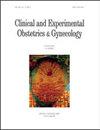Development of patient-centered outcomes for labour and birth: a qualitative study
IF 0.6
4区 医学
Q4 OBSTETRICS & GYNECOLOGY
引用次数: 0
Abstract
Background: Current quality improvement models in obstetrics focus on prevention of adverse perinatal outcomes. The development of these metrics was based on expert opinion that did not account for patients’ values. The ultimate aim of our research is to develop performance indicators for labour and birth that reflect the patient perspective. Methods: A qualitative interview design was used to engage a convenience sample, of recent (<1 year) postpartum patients, in semi-structured interviews, where they shared their experiences of their recent birth. Patients were also asked to assess descriptions of adverse perinatal outcomes for readability and comprehension, towards developing accurate unbiased descriptions for a subsequent survey of patients to weight complications. Responses were recorded, transcribed, coded and analyzed using thematic analysis. thematic analysis. Results: Five themes emerged during the analysis: (1) desire for patient-centred care, (2) improved communication, (3) labour/birth, expectations and outcomes, (4) care team support during labour and birth, (5) continuing emotional and physical postpartum care. Conclusions: Patient-centred care and good health outcomes were the major values expressed by the patients in this study. Good communication and shared decision making led to patients describing their labour and birth as a satisfying experience. This study lays the foundation for developing a quality tool to measure the outcomes of birth and adverse outcomes from the patients’ perspective.以患者为中心的分娩和出生结果的发展:一项定性研究
背景:当前产科质量改进模式侧重于预防不良围产期结局。这些指标的制定是基于没有考虑患者价值观的专家意见。我们研究的最终目的是制定反映患者观点的分娩和分娩绩效指标。方法:采用定性访谈设计,对最近(<1年)产后患者的便利样本进行半结构化访谈,分享他们最近分娩的经历。患者还被要求评估围产期不良结果的描述,以提高可读性和理解力,从而为随后对患者体重并发症的调查制定准确、无偏见的描述。采用主题分析法对答复进行记录、转录、编码和分析。专题分析。结果:分析中出现了五个主题:(1)渴望以患者为中心的护理,(2)改善沟通,(3)分娩/分娩、期望和结果,(4)分娩和分娩期间的护理团队支持,(5)持续的产后情感和身体护理。结论:以患者为中心的护理和良好的健康结果是本研究中患者表达的主要价值观。良好的沟通和共同的决策使患者将分娩和分娩描述为一种令人满意的体验。这项研究为开发一种从患者角度衡量出生结果和不良结果的高质量工具奠定了基础。
本文章由计算机程序翻译,如有差异,请以英文原文为准。
求助全文
约1分钟内获得全文
求助全文
来源期刊
CiteScore
0.50
自引率
0.00%
发文量
241
审稿时长
1 months
期刊介绍:
CEOG is an international, peer-reviewed, open access journal. CEOG covers all aspects of Obstetrics and Gynecology, including obstetrics, prenatal diagnosis, maternal-fetal medicine, perinatology, general gynecology, gynecologic oncology, uro-gynecology, reproductive medicine, infertility, reproductive endocrinology, sexual medicine. All submissions of cutting-edge advances of medical research in the area of women''s health worldwide are encouraged.

 求助内容:
求助内容: 应助结果提醒方式:
应助结果提醒方式:


